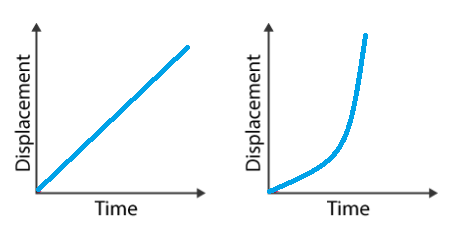
What information about the motion of a body can be obtained from its displacement-time graph?
A) Velocity of the body
B) Acceleration of the body
C) Force on the body
D) Retardation of the body
Answer
468.3k+ views
Hint: In this question, we can use the concept that if a graph is plotted between two quantities then the two quantities are in ratio. We have to identify the ratio of displacement and time for the correct option.
Complete step by step answer:
We know when a body is moving than in a finite time the body covers a finite displacement.
When we plot a graph between the displacement and the time then we get a straight line or curve as the slope or gradient. While plotting the graph, we get two types of slopes. A straight line for uniform motion and a curve for non-uniform motion.

In a displacement-time graph, the slope or gradient of the slope is always equal to the velocity of the body. If the slope is straight then the motion is uniform and the body has constant velocity. If the slope is a curve then the motion is non-uniform and the body has variable velocity.
Hence option A correct.
Additional Information:
The slope of a velocity-time graph gives the acceleration of that body. If the slope of the velocity-time graph goes downwards then the slope of the graph shows the retardation of that body.
Note:
We have to remember that the ratio of displacement and time is always equal to velocity and the ratio of velocity and time is always equal to the acceleration of the body. A graph is always plotted between those quantities which are in some ratio. So, we have to remember the definitions of velocity and acceleration.
Complete step by step answer:
We know when a body is moving than in a finite time the body covers a finite displacement.
When we plot a graph between the displacement and the time then we get a straight line or curve as the slope or gradient. While plotting the graph, we get two types of slopes. A straight line for uniform motion and a curve for non-uniform motion.

In a displacement-time graph, the slope or gradient of the slope is always equal to the velocity of the body. If the slope is straight then the motion is uniform and the body has constant velocity. If the slope is a curve then the motion is non-uniform and the body has variable velocity.
Hence option A correct.
Additional Information:
The slope of a velocity-time graph gives the acceleration of that body. If the slope of the velocity-time graph goes downwards then the slope of the graph shows the retardation of that body.
Note:
We have to remember that the ratio of displacement and time is always equal to velocity and the ratio of velocity and time is always equal to the acceleration of the body. A graph is always plotted between those quantities which are in some ratio. So, we have to remember the definitions of velocity and acceleration.
Recently Updated Pages
The correct geometry and hybridization for XeF4 are class 11 chemistry CBSE

Water softening by Clarks process uses ACalcium bicarbonate class 11 chemistry CBSE

With reference to graphite and diamond which of the class 11 chemistry CBSE

A certain household has consumed 250 units of energy class 11 physics CBSE

The lightest metal known is A beryllium B lithium C class 11 chemistry CBSE

What is the formula mass of the iodine molecule class 11 chemistry CBSE

Trending doubts
The reservoir of dam is called Govind Sagar A Jayakwadi class 11 social science CBSE

10 examples of friction in our daily life

What problem did Carter face when he reached the mummy class 11 english CBSE

Difference Between Prokaryotic Cells and Eukaryotic Cells

State and prove Bernoullis theorem class 11 physics CBSE

Proton was discovered by A Thomson B Rutherford C Chadwick class 11 chemistry CBSE




